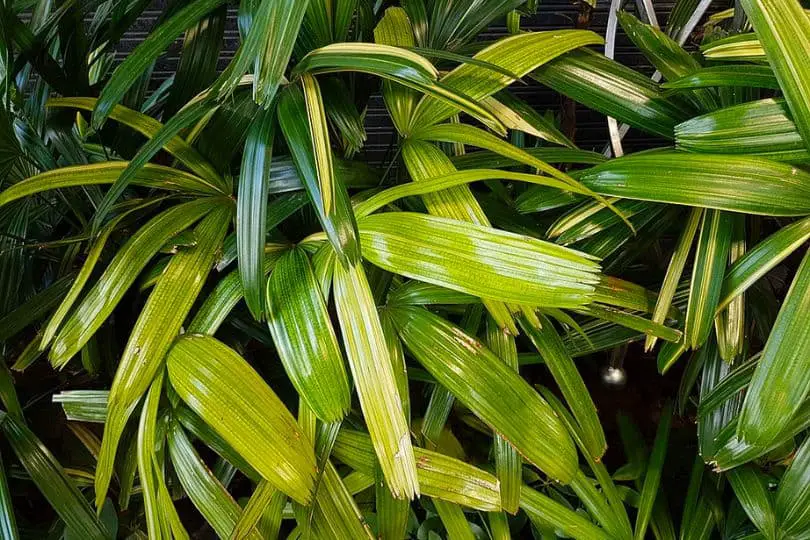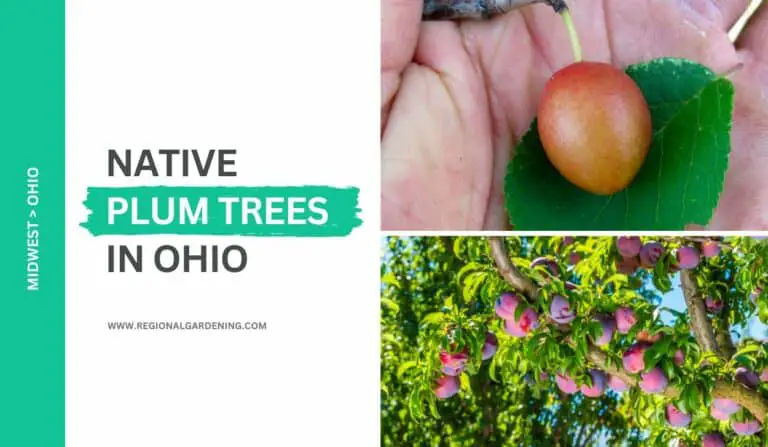4 Palm Trees In Ohio (Indoor/Outdoor Palms)

Despite the contrasting environment, palm trees in Ohio add a touch of exotic appeal to the Buckeye State.
There are several types of palm trees that thrive in both indoor and outdoor environments in Ohio. With their distinctive leaves and elegant appearance, these palm trees add a touch of sophistication to any setting.
So, whether you want to add a tropical touch to your home or create a backyard oasis, palm trees provide both beauty and utility. And, to help you choose, we have compiled a list of four commonly grown palm trees in Ohio.
So, let’s begin.
1. Areca Palm

- Scientific Name: Dypsis lutescens
- Common Name(s): Areca Palm, Butterfly Palm, Yellow Palm
- Mature Height: 6-12 feet (1.8-3.7 meters)
- Native Region: Madagascar
- Flowers: Areca palms produce small, yellow flowers in clusters on long arching stems.
- Fruit: The fruit of the Areca palm is a small, round, yellow berry-like drupe.
- Uses: Areca palms are commonly used as indoor and outdoor decorative plants, adding a tropical touch to landscapes. They are also popular as houseplants due to their ability to purify the air by removing pollutants.
The Areca palm (Dypsis lutescens) is one of the most popular indoor and outdoor palm trees in Ohio. It is also known as the Areca palm, Butterfly palm, or Yellow palm. This palm variety can grow to a mature height of 6-12 feet, making it a great choice for adding a tropical touch to any setting.
The fluffy, arching fronds of the Areca palm, which is native to Madagascar, are what set it apart. The palm has very slender trunks that are light green and might develop a tiny curve as it grows. Areca palm fronds are pinnate and can grow to be up to 8 feet long. Each frond is made up of several leaflets that are a brilliant, glossy green color.
The Areca palm flourishes in tropical and subtropical conditions in its native habitat. It can, however, be cultivated successfully in Ohio as an indoor houseplant or as a container plant taken indoors during the colder months. It prefers well-draining soil and moderate shade when planted outside to protect its leaves from direct sunshine, which can cause scorching.
The Areca palm has little yellow flowers in groups on high arching stalks, which adds to its beauty. Small, spherical, yellow berries typically follow these blossoms, giving the palm a pleasing aesthetic feature. Although people don’t typically eat the berries, they do provide food for birds and other animals.
It is critical to ensure that Areca palm trees in Ohio receive appropriate moisture without being overwatered. The soil should be kept moist but not saturated, as this might cause root rot. A balanced fertilizer applied regularly can assist in encouraging healthy growth. Misting the leaves regularly can also assist in enhancing humidity, which the palm prefers.
The Areca palm is extremely adaptable and can be used in a wide range of landscape settings. It is frequently used as a focal plant in gardens or indoor settings such as businesses or residences.
The gorgeous foliage of the palm, as well as its ability to easily filter indoor air pollutants, make it a great choice for enhancing indoor air quality. Its exotic appearance and low-maintenance requirements make it a popular choice for Ohioans wishing to include a tropical touch into their landscapes.
2. Chinese Fan Palm

- Scientific Name: Livistona chinensis
- Common Name(s): Chinese Fan Palm, Fountain Palm, Fountain Tree
- Mature Height: 15-25 feet (4.5-7.6 meters)
- Native Region: East Asia (China, Japan, Taiwan)
- Flowers: Creamy-white, small flowers arranged in panicles
- Fruit: Small, round, black berries
- Uses: Ornamental tree for indoor and outdoor landscapes, used as a houseplant or accent plant in gardens and parks.
The Chinese Fan Palm (Livistona chinensis) is among the most popular palm trees in Ohio and is commonly seen in both indoor and outdoor landscaping in the state. It can grow to a mature height of 15 to 25 feet (4.5 to 7.6 meters), making it an excellent choice for medium-sized gardens or as a focal point in larger locations.
This palm tree is indigenous to East Asia, primarily China, Japan, and Taiwan. It is well-adapted to a variety of climates and, with proper care, can grow in Ohio’s temperate environment. The Chinese Fan Palm has a short trunk with rough, gray-brown bark and leaves that develop in a distinctive fan form. The leaves are dark green and can grow to be 3 feet (0.9 meters) long.
The Chinese Fan Palm offers a tropical flair to the outside landscape and creates a lovely focus point. It can be planted as a single specimen or in a cluster to provide a beautiful green paradise. It is widely grown as a houseplant inside because of its flexibility to diverse light conditions, yet it excels in bright, indirect light.
The Chinese Fan Palm blooms in panicles of creamy-white flowers in the spring and summer. Following these blossoms come small, spherical, black berries that provide aesthetic appeal to the tree. While the berries are not edible to people, they are beneficial to birds and other wildlife.
The Chinese Fan Palm requires constant irrigation in Ohio, especially during dry periods. It prefers well-draining soil and should be treated during the growing season using a balanced palm-specific fertilizer. In the winter, it can endure colder temperatures but may require frost protection.
The Chinese Fan Palm is revered not just for its aesthetic appeal, but also for its many applications. Its beautiful appearance makes it a good choice for home and commercial landscaping projects. Furthermore, this palm tree is proven to improve interior air quality by filtering contaminants, making it an excellent choice for offices and residences. The Chinese Fan Palm, whether cultivated indoors or outdoors, offers a touch of elegance and calm to any landscape.
3. Kentia Palm

- Scientific Name: Howea forsteriana
- Common Name(s): Kentia Palm, Thatch Palm
- Mature Height: 10-20 feet (3-6 meters)
- Native Region: Lord Howe Island, off the east coast of Australia
- Flowers: No Flowers
- Fruit: Small, black, spherical fruit
- Uses: Kentia palm is commonly used as an indoor plant, adding a touch of tropical elegance to homes and offices. It is also utilized in landscaping as a focal point or accent plant in outdoor landscapes.
The Kentia Palm (Howea forsteriana) is a popular choice for both indoor and outdoor settings in Ohio. It provides a touch of tropical elegance to any environment with its graceful arching fronds and thin trunk. Lord Howe Island, off Australia’s east coast, is home to the Kentia Palm.
This palm tree grows slowly and can reach a mature height of 10-20 feet (3-6 meters). The feather-like, dark green fronds of the Kentia Palm grow in an arching pattern. The fronds can grow to be up to eight feet (2.4 meters) long. The trunk of the Kentia Palm is slim and can be a lovely, self-cleaning brown color.
The Kentia Palm is mostly utilized as an indoor plant in Ohio. It prefers a well-draining potting mix and thrives in bright, indirect light. Because this palm prefers a humid environment, spraying the fronds or laying the pot on a tray of water will assist in raising humidity levels. The Kentia Palm is frequently utilized as a focal point or accent plant in outdoor settings. It is best suited for planting in large planters and bringing indoors during the colder months in Ohio.
One of the Kentia Palm’s key advantages is its tolerance for reduced light levels, which makes it appropriate for Ohio’s interior surroundings. It is a low-maintenance plant that only has to be watered on occasion and may flourish in ordinary room temperatures. Wiping the fronds to eliminate dust and dirt on a regular basis can keep them looking fresh and lively.
Aside from its decorative value, the Kentia Palm serves no purpose. Its visual appeal, on the other hand, makes it a popular choice for bringing a touch of tropical flair to Ohio homes, workplaces, and outdoor landscapes. Its lovely arching fronds and slender trunk provide an oasis-like ambiance, bringing you to a peaceful holiday place without requiring you to leave the comfort of your own home.
4. Lady Palm

- Scientific Name: Rhapis excelsa
- Common Name(s): Lady Palm
- Mature Height: 6-12 feet (1.8-3.7 meters)
- Native Region: Southern China
- Flowers: No Flowers
- Fruit: Small black fruits
- Uses: Popular as an indoor plant, often used in landscaping for its attractive foliage and tolerance to low light conditions.
The Lady Palm, scientifically known as Rhapis excelsa, is a popular palm tree found in both indoor and outdoor landscapes throughout Ohio. It is a multipurpose plant that may be grown both indoors and outdoors. The Lady Palm is native to Southern China and has long been a favorite of plant aficionados.
This palm tree matures to a height of 6-12 feet (1.8-3.7 meters), making it ideal for medium-sized landscapes. It has a feathery appearance due to its cluster of slender, dark green fronds with delicate leaflets. The leaves are segmented, giving them a fan-like form. The Lady Palm’s trunk is slender and coated in fibrous bark.
The Lady Palm loves partial shade or filtered sunshine in its habitat, making it a great choice for indoor spaces with little natural light. It can also withstand outdoor circumstances and can be planted in parts of the garden that are shaded or semi-shaded. It is advised that the Lady Palm be protected from freezing temperatures during the winter months in Ohio.
The Lady Palm is well-known for its hardiness and ability to survive in low-light environments. It is a popular indoor plant since it is a good choice for homes and offices with restricted sunshine. It is also widely utilized to bring a touch of tropical elegance to landscape projects.
The Lady Palm does not have beautiful flowers, but it does have little black fruits that lend visual interest to the shrub. These fruits are not edible and are primarily decorative.
In Ohio landscapes, caring for the Lady Palm entails providing it with well-draining soil, regular watering, and occasional fertilizing. To avoid root rot, it is critical to avoid overwatering. Indoor plants should be put in an area that receives indirect sunlight and away from drafts. Outdoor plants should be protected from extreme cold and wind.
Similar Articles
- White Flowering Trees In Ohio
- Yellow Flowering Trees In Ohio
- Common Oak Trees In Ohio
- Common Willow Trees In Ohio
- Common Purple Trees In Ohio
- Common Pine Trees In Ohio
- Common Birch Trees In Ohio
- Common Ash Trees In Ohio
- Native Cherry Trees In Ohio
- Native Hickory Trees In Ohio
- Common Elm Trees In Ohio
- Common Spruce Trees In Ohio
- Common Poplar Trees In Ohio
- Common Nut Trees In Ohio
- Common Cedar Trees In Ohio
- Common Maple Trees In Ohio
- Native Plum Trees In Ohio
- Native Aspen Trees In Ohio
- Common Locust Trees In Ohio
Common Palm Trees In Ohio – Sources
The Regional Gardening team makes sure that the information in our articles is accurate by only using sources that are known to be trustworthy. Some of these sources are peer-reviewed journals from government agencies, well-known universities, and scientific research organizations.
- Trees Of Ohio, Division Of Wildlife
- Trees Of Ohio Field Guide, Book by Stan Tekiela
- Ohio Trees, OSU Extension Publications
- Native Plant Lists, Ohio Department Of Natural Resources
- Ohio Department Of Agriculture
- Gardening, The Ohio State University







